NXT Coin Review: A Deep Dive into the Original Blockchain 2.0
Nxt is one of the oldest cryptocurrencies, and is more than just that, but is an entire platform that was developed with the aim of improving on modern blockchain technology.
In fact, NXT was one of the first "developer" blockchains that aimed to provide more than a mere transaction record keeping. They wanted to create a network that would allow other projects to develop their blockchains on the back of it.
Updated in 2016, the NXT network keenly adopted its moniker and labelled its newer version "NXT 2.0".
Since then, NXT has not received as much coverage as some of the other smart contract based blockchains, but is it still an interesting project? We will take a deeper look in this complete review.
What Is Nxt Blockchain 2.0?
Nxt was developed as a way to improve on the existing Bitcoin blockchain, providing a new way to provide crowdfunding, governance, and to revolutionize the existing financial technology. All of this is meant to be provided by the Nxt coin.
The Nxt developers went a step further though, also introducing a modular toolset that allows developers to use the Nxt blockchain to create a variety of additional applications that extend the functionality of the Nxt blockchain and network.
The platform was created to cater to both individual users and businesses. Already Nxt can be used as an exchange to trade other cryptocurrencies, as a way to create your own cryptocurrency based on the Nxt blockchain, or as a way to decentralize voting and to store data.
Nxt is the future of blockchain technology, and is already referred to as Nxt 2.0 even though it was one of the first cryptocurrencies developed after Bitcoin emerged, having been introduced in November 2013.
The History of Nxt

Nxt was first mentioned in a Bitcointalk.org thread on September 28, 2013 by an anonymous user calling themselves BCNext. That user ran a crowdfunding for the development of Nxt, raising 21 BTC (at the time Bitcoin was worth around $250).
Nxt was quickly developed and launched in November, with the genesis block being published on November 24, 2013.
It was unique in that it was written from scratch in Java, and was the very first blockchain to use proof of stake exclusively as a consensus method. A total of 1 billion coins were created and distributed to the 73 original stakeholders based on their contribution level.
Part of the Nxt source code was released January 3, 2014 and the full source code was released as open source under the MIT license on March 1, 2014.
BCNext eventually stepped away from the Nxt project and development was taken up by The Nxt Foundation. However, due to a lack of resources The Nxt Foundation was unable to guide to project effectively, and rights were sold to Jelurida BV who currently handles development for Nxt.
How Does Nxt Work?
Nxt is a proof of stake blockchain, which means there is no mining involved as there is with Bitcoin. It also means the coin supply is static. The 1 billion coins initially created is all there will ever be.
The platform was designed with offering financial services and building additional applications as its main focus. And it has excelled in that function, with a large number of services and applications being developed and released on the Nxt blockchain since its 2013 inception.
As was mentioned above, Nxt was not created as a clone of the Bitcoin code, but was written from scratch in Java, which gives it several unique technological features not found with other blockchains. It was also the very first cryptocurrency to work solely on a proof of stake consensus mechanism, and initially had a block creation rate on approximately one minute.
The Nxt client was also unique when launched as it worked as a brain wallet. This meant your keys were not kept in a wallet file, and that your account could be accessed from any instance of the Nxt client via your secret passphrase.
Developed Nxt Features
Nxt was developed to be multi-functional, and has had many features added over the years. Here are some of the features that have been implemented, or are planned for future development:

Asset Exchange:
The Nxt Asset Exchange was create to offer secure, direct peer-to-peer trading, but with a difference. Users are able to easily create their own projects on Nxt through this exchange. The exchange will allow trading of crypto assets, but also of items other than coins and tokens.
It does this by creating a trading record that “colors” the asset to designate it as a digital asset. It’s not that much different from colored coins in the Bitcoin world, and can be used to build a bridge between the digital and physical world.
By using this feature a Nxt based asset can be anything at all, from cryptocurrencies to stocks or bonds, even real estate or ideas could be saved on the Nxt blockchain, immutably.
Monetary System:
In conjunction with the aforementioned asset exchange, users can easily launch their own cryptocurrency with Nxt, similar to the Ethereum based tokens, and can then trade, exchange and share between any other currencies supported by Nxt.
Data Cloud:
Nxt was created to allow for data storage, and users are able to access the data cloud system to store, publish and verify data on the blockchain. It is secure, simple and effective and could be used to great effect for documents such as contracts, wills, deeds, and any other document that requires secure, verifiable creation and storage.
Messaging System:
With the Arbitrary Messages system coded into Nxt you are able to transmit messages in either plain text or encrypted. It is tied in with the data storage system, and allows users to store up to 1,000 bytes of data permanently, or 42,000 bytes of data on a temporary basis.
The data cloud mentioned above actually evolved out of the Arbitrary Messages system, and it has also been used as a file sharing service for decentralized applications (Dapps).
Voting System:
One game changing feature is the ability to create customized polls on the Nxt blockchain. It requires the use of Nxt coins or some other Nxt based asset, but anyone can create a poll for voting in a cryptographically verified manner. Votes can be used for any purpose, and this feature could do away with poll and voter fraud.
Account Control:
It’s possible to create multi-signature accounts with Nxt, and the Nxt developers have promised to make it easier to run a decentralized autonomous organization (DAO) using the Nxt blockchain.
Authentication System:
Publically prove that you are the owner of a Nxt account through cryptographically secure data verification.
Plugins:
Nxt is modular, allowing for the development of third-party plugins to extend the functionality of Nxt in ways that likely haven’t even been dreamt up yet.
Alias System:
Nxt includes a clever Alias System which allows one piece of text to be substituted for another. This paves the way to create systems in which keywords can represent other things, and could be used extensively in shopping cart applications, decentralized DNS systems, and much more.
Account Ledger:
The Nxt account ledger system is designed to be easy to read, so any user can quickly and easily see their account balance and any transactions that have taken place. If you’re familiar with bank statements you’ll be just as at home using the Nxt account ledger.

Account Properties:
Nxt allows for tagging of other accounts with meta-data, which could be used in a variety of ways. For example, a seller could tag all previous buyers.
How Does The NXT Coin Work?
The Nxt token is the cryptocurrency that fuels transactions on the Nxt network. It is used as the transaction fee when making transfers from one user to another. It can also be used to create “colored coins” or assets that represent other digital or even real world physical assets. In addition, it is used to fuel voting or to store data. Everything done on the Nxt blockchain and in the network is fueled by the Nxt token.
And of course you can use Nxt like any other digital currency, paying for goods or services, or simply trading it on exchanges just as you would Bitcoin, Ethereum, or any other cryptocurrency. Nxt is available on some of the largest cryptocurrency exchanges, such as HitBTC, Poloniex and Bittrex, among others.
The Future Of Nxt
Nxt is continuing to be developed and supported, however the company that develops Nxt has been more heavily focused on their new project called Ardor and its child chain Ignis. Ardor is considered to be an improved version of Nxt and is lightweight and more scalable. It also allows for the creation of as many sidechains, or child chains as necessary, and Ignis will be the very first of these.
Nxt holders received an airdrop of Ardor (ARDR) and Ignis (IGNIS) at a ratio of 1:1 and 1:0.5 respectively at the genesis of the Ardor blockchain on January 1, 2018.
Ultimately, the future looks bright for Ardor, and the platform has ambitious plans for the future. However, a review of Ardor and Ignis are outside the scope of our Nxt overview.
In Conclusion
Nxt was the original proof of stake coin, and is considered by some to be the realization of blockchain 2.0 – an improved version of Bitcoin built with Java.
It has lost its luster over the years, and other blockchain 2.0 technologies have stolen its limelight, but it is still a powerful and unique blockchain. With the development of Ardor, the Jelurida group hopes to restore its grip on blockchain 2.0 technology, with an improved and scalable solution.
You can learn more about Nxt here or get involved in its active community of enthusiasts and developers. You’ll also find a download for the Nxt client, as well as an online demo to show you how the client functions before you download.
Disclaimer: These are the writer’s opinions and should not be considered investment advice. Readers should do their own research.
